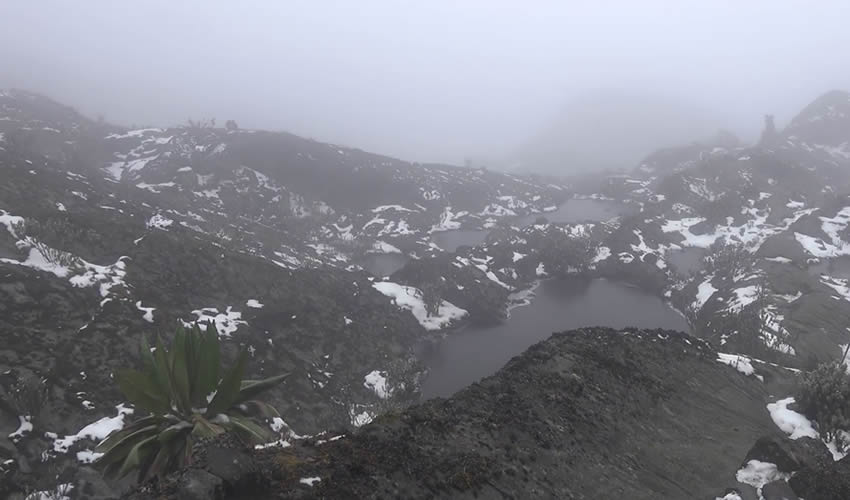 The Rwenzori Mountains were called the Ruwenzori Ranges, the spelling changed 1980 to conform more closely to the local name “Rwenjura” which means heavy rain. It was also named the Mountains of the Moon by explores. Mount Rwenzori is located in Western Uganda in the East African Rift Valley which straddles to the Democratic Republic of Congo.
The Rwenzori Mountains were called the Ruwenzori Ranges, the spelling changed 1980 to conform more closely to the local name “Rwenjura” which means heavy rain. It was also named the Mountains of the Moon by explores. Mount Rwenzori is located in Western Uganda in the East African Rift Valley which straddles to the Democratic Republic of Congo.
The Rwenzori Mountains reach heights up to 5,109 m (16,761 ft.) at 0°23′09″N 29°52′18″ECoordinates: 0°23′09″N 29°52′18″E. The highest Rwenzori peaks are permanently snow-capped, and along with Mount Kilimanjaro and Mount Kenya are the only mountains in Equatorial Africa. Rwenzori Mountains National Park and Virunga National Park are located in the same range.
The mountainRwenzori is the third highest in Africa up rising to more than 16,700 feet above sea level with its highest peaks rising above the clouds that are iced.Margherita Peak on Mount Stanley is the highest point of the range. It was formed about three million years ago in the late Pliocene, as a result of an uplifted block of crystalline rocks including: gneiss, amphibolite granite, and quartzite. They are on the flanks of the Albertine Rift, the western branch of the East African Rift. The uplift divided the paleolakeObweruka and created three lakes of the Great Lakes in Africa and these include: Lake Albert, Lake Edward, and Lake George.
Rwenzori Mountains consist of the 6 ranges separated by the gorges these are; Mount Stanley, Mount Speke, Mount Baker, Mount Emin, Mount Gessis and Mount Savoia. The ranges are high compare to the Alps and have glaciers which are sources of the longest river on earth. Margherita is the highest peak making it the third highest peak in Africa.
The mountain is also UNESCO /among world’s heritage site with unique characteristics which covers almost 1000 sq. km that cut across the districts of Kabarole, Kasese, and Bundibugyo.
The area has beautiful plant life coupled with Kabamba waterfalls, glaciers and a lot of other attractive mountainous vegetation. There are huge tree-heather, colourful mosses, giant lobelia, everlasting flowers, 70 species of mammals, 217 species of birds, and some primates. It’s a home to the rare three-horned chameleon.
Mountain climbing , wildlife viewing, and nature walk are the major activities of the area. The mountain can be hiked up to the summit of Margherita by going through Bwamba passing in Bundibugyo for a maximum number of 9-12 days.Kilembe in kasese district
The Rwenzori range is the home of the Bakonjo and Bamba peoples. In the early 1900s, these two tribes were added to the Toro Kingdom by the colonial powers. The two tribes’separated from Toro in the 1950s, a movement that became Rwenzururu, an armed secessionist movement, by the mid-1960s. The insurgency ended through a negotiated settlement in 1982, though the Rwenzururu Kingdom was acknowledged by the government of Uganda in 2008.
The vegetation is ranging from tropical rainforest through alpine meadows to snow. The mountain ranges support its own species and varieties of giant groundsel and giant lobelia and even has a six metre high heather covered in moss that lives on one of its peaks. Making it a World Heritage Site and is covered jointly by the Rwenzori Mountains National Park in south-western Uganda, and the Virunga National Park in the Eastern Democratic Republic of the Congo.
The flora in the Rwenzori is closely related to that of other East-African high mountains, but it is more unique here. This is because of the high rainfall in the area. The distribution of vegetation is for a good deal determined by the altitude. At higher elevations, certain genera of plants grow unusually large. Most surprising are the giant heathers, senecios and lobelias, to which the Swedish botanist OlovHedberg from the Uppsala University referred to as “botanical big game”. As the altitude increases, temperatures drop. The air also grows thinner, provoking intense radiation, even on clouded days. During the day the incoming radiation of ultraviolet and infrared light is fierce, while at night the outward radiation under a clear sky has a considerable cooling effect. The equatorial location dictates marked diurnal variations in temperature, whereas the seasonal differences are less important, as if it were summer every day, winter every night.
There can never be water shortage in the Rwenzori. Yet several members of the afroalpine family bear resemblance with species that normally thrive in desert climates. This is because the area is covered with permanent ice available to the afroalpine plants when they need it.
